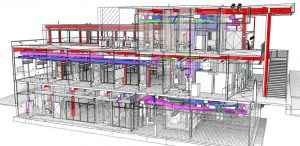BIM, What Is It?
BIM or Building Information Modelling is a process for creating and man aging information on a construction project across the project lifecycle. One of the key outputs of this process is the Building Information Model, the digital description of every aspect of the built asset. This model draws on information assembled collaboratively and updated at key stages of a project. Creating a digital Building Information Model enables those who interact with the building to optimize their actions, resulting in a greater whole life value for the asset.
aging information on a construction project across the project lifecycle. One of the key outputs of this process is the Building Information Model, the digital description of every aspect of the built asset. This model draws on information assembled collaboratively and updated at key stages of a project. Creating a digital Building Information Model enables those who interact with the building to optimize their actions, resulting in a greater whole life value for the asset.
Through BIM, the UK construction industry is undergoing its very own digital revolution. BIM is a way of working. BIM is information modelling and information management in a team environment, all team members should be working to the same standards as one another. BIM creates value from the combined efforts of people, process and technology.
BIM brings together all of the information about every component of a building (BIM Objects), in one place. BIM makes it possible for anyone to access that information for any purpose, e.g. to integrate different aspects of the design more effectively. In this way, the risk of mistakes or discrepancies is reduced, and abortive costs minimized.
BIM data can be used to illustrate the entire building life-cycle, from inception and design to demolition and materials reuse. Spaces, systems, products and sequences can be shown in relative scale to each other and, in turn, relative to the entire project. And by signalling conflict detection BIM prevents errors creeping in at the various stages of development/ construction.
Why is BIM Important
The Government’s Industrial Strategy, published in early 2013, states that £40 billion of public money is spent on Centrally Funded Public buildings, every year. From this, millions of pounds are lost through poor integration and not learning from past mistakes. The strategy suggests that:
- 30% of the construction process is rework
- 60% of the labour effort is wasted
- 10% loss is due to wasted materials
- 3-5% of the construction turnover is wasted due to loss of interoperability.
It follows that construction information is, therefore, often:
- Inaccurate
- Incomplete
- Ambiguous.
Using BIM, By 2025, Government is aiming to maximise efficiency in the construction industry through legislation and best practices aimed at:
- Lowering costs
- Speeding delivery
- Lowering emissions
- Increasing exports.
What Is A BIM Object?
A BIM object is a combination of many things:
- Information content that defines a product
- Product properties, such as thermal performance
- Geometry representing the product’s physical characteristics
- Visualisation data giving the object a recognisable appearance
- Functional data, such as detection zones, that enables the object to be positioned and behave in the same manner as the product itself.
Firstly, in order to fit within the BIM process our product information has been transformed into smart data. Data that is easily searchable and easy to filter. Data that anyone can understand, data that machines and software can read. Having our product data in BIM means that anyone who uses our data benefits from its seamless flow along the construction supply chain.
Secondly, our product data is standardized. The standardization of data leads to the standardization of work. Our data is consistently structured, so that anyone can find whatever they need within our data repository. So that you can export different types of data to the different entities who require it.
Thirdly, our BIM product data is interoperable. That means that it needs to be shareable in multiple formats, multiple languages and along different software tools that are widely used by the construction industry. That also means that it has to be interlinked and the relationships between products and their properties need to transfer as well.
Why Choose Challis BIM Products
All our primary products have now been BIMed or transfomred into BIM smart data now available for quick and easy download straight into your specification. Click Here
